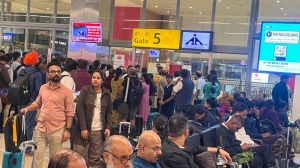Siberian cranes give Bharatpur a miss
This year, the Siberian cranes have not made their annual flight to Bharatpur and after a gap of seven years, the Keoladeo National Park has...

This year, the Siberian cranes have not made their annual flight to Bharatpur and after a gap of seven years, the Keoladeo National Park has not seen the winged visitors. The single pair that visited the park last year has not revisited this year.
‘‘I hope they arrive but it looks unlikely. I have been observing the pair that has been visiting the park for the last few years and figured that the female crane was quite old and weak to reproduce and may have died. In such a case the chances of the male crane travelling all this distance alone is really remote,’’ says Bachhu Singh Gujjar, a field assistant with the World Wildlife Fund (WWF).
|
Chilika too sees fewer birds
|
|
Bhubaneswar: Chilka Lake has for years been a favourite destination for migratory birds that fly in from as far away as Siberia but census figures show that the number of migratory birds has dropped drastically in the last couple of years. According to census figures, only 4.5 lakh birds have arrived at Asia’s largest brackish water lagoon this winter as against 15 lakh last year. On a single day, about 89 migratory bird species were sighted by the 14 expert groups that carried out the two-day census this year. The decreasing number of birds visiting the lagoon has taken experts by surprise and the Bombay Natural History Society is researching into the matter. In 2000, 10 lakh birds were sighted inside the Nalabana Bird Sanctuary. The number dropped to six lakh the next year and to 2.33 lakh in 2002. This year, only 1.7 lakh birds have visited the sanctuary. While the reason behind the fall in the number of migratory birds still remains a mystery, experts believe that scarcity of food in the lagoon could be one factor. Said a State Wildlife Department official, ‘‘Birds migrate to wherever they get food. Insufficiency of food can be one of the reasons behind their not coming to Chilika,’’ he said. He added that after a new mouth was opened to raise the salinity level of the lagoon, freshwater weeds have died. ‘‘Once the salinity level went up in the sanctuary area, the freshwater weeds died. And the winged visitors possibly went to peripheral areas in search of food,’’ said the official. SIBA MOHANTY Story continues below this ad |
According to Park director B. Pravin,‘‘There have been no sightings this year. If we go by data collected through the ’60s, the birds reach Indian shores by December end and they have not arrived till now.’’ The drought in Rajasthan is cited as one of the reasons for their non arrival.‘‘We are reeling under severe drought conditions and the water sources have dried up. This is why the birds have visited,’’says Pravin.
According to the International Crane Federation (ICF) , the central population of the endangered Siberian Crane that migrates to the Keoladeo National Park contained more than 30 individuals through the early 1980s. No birds were seen on the wintering grounds in 1993-94 and 1994-95. Four cranes reappeared at the Park in February 1996.
Based on this data, Pravin is hopeful that though no cranes have visited the park this time, they will reappear, just like they did in 1996. But bird watchers are not so sure.
Avid bird watcher Harkeerat Singh Sangha says,‘‘The birds will not come back. Actually, we expected them not to return since last three years, but they came. Maybe if more conservation measures had been taken, it could have been different.’’
ICF statistics indicate there has been a steady decline in the winter counts at the Park, from 80 odd birds in the 1960s to just a single pair in 2001. Siberian cranes are strictly protected in their breeding grounds in Russia and on their wintering grounds in India.
According to the ICF ‘‘attrition of the population is attributed to hunting during migration, particularly in Afghanistan for subsistence during the long war, and in Pakistan where there are strong traditions of hunting’’.
- 01
- 02
- 03
- 04
- 05































